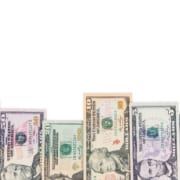Know Your Money. Tips For Identifying Counterfeit Money.
Counterfeit money is a problem we all need to guard against. Being aware of the safety features of U.S. currency is a great way to guard against accepting counterfeit money. Don’t fall victim and be left on the losing end.
The secret service and U.S. Treasury also offer these suggestions:
- Holograph: Hold a bill up to a light and look for a holograph of the face image on the bill. Both images should match. If the $100 bill has been bleached, the hologram will display an image of Abraham Lincoln, who appears on the $5 bills, instead of Benjamin Franklin.
- Strip: Looking at the bill through a light will also reveal a thin vertical strip containing text that spells out the bill’s denomination.
- Color-shifting ink: If you hold the new series bill (except the $5 note) and tilt it back and forth, please observe the numeral in the lower right hand corner as its color shifts from green to black and back.
- Watermark: Hold the bill up to a light to view the watermark in an unprinted space to the right of the portrait. The watermark can be seen from both sides of the bill since it is not printed on the bill but is imbedded in the paper.
- Security Thread: Hold the bill up to a light to view the security thread. You will see a thin imbedded strip running from top to bottom on the face of a banknote. In the $10 and $50 the security strip is located to the right of the portrait, and in the $5, $20 and $100, it is located just to the left of the portrait.
- Ultraviolet Glow: If the bill is held up to an ultraviolet light, the $5 bill glows blue; the $10 bill glows orange, the $20 bill glows green, the $50 bill glows yellow, and the $100 bill glows red – if they are authentic!
- Microprinting: There are minute microprinting on the security threads: the $5 bill has “USA FIVE” written on the thread; the $10 bill has “USA TEN” written on the thread; the $20 bill has “USA TWENTY” written on the thread; the $50 bill has “USA 50” written on the thread; and the $100 bill has the words “USA 100” written on the security thread. Microprinting can be found around the portrait as well as on the security threads.
- Fine Line Printing Patterns: Very fine lines have been added behind the portrait and on the reverse side scene to make it harder to reproduce.
- Comparison: Compare the feel and texture of the paper with other bills you know are authentic.
The Secret Service offers a downloadable PDF called Know Your Money. It points out key features to look at to determine if a bill is real or fake.




